Global Marketing and Communication
VerifiedAdded on 2022/12/15
|12
|2833
|369
AI Summary
This document provides an introduction to global marketing and communication, including global strategies and product glocalized strategy.
Contribute Materials
Your contribution can guide someone’s learning journey. Share your
documents today.
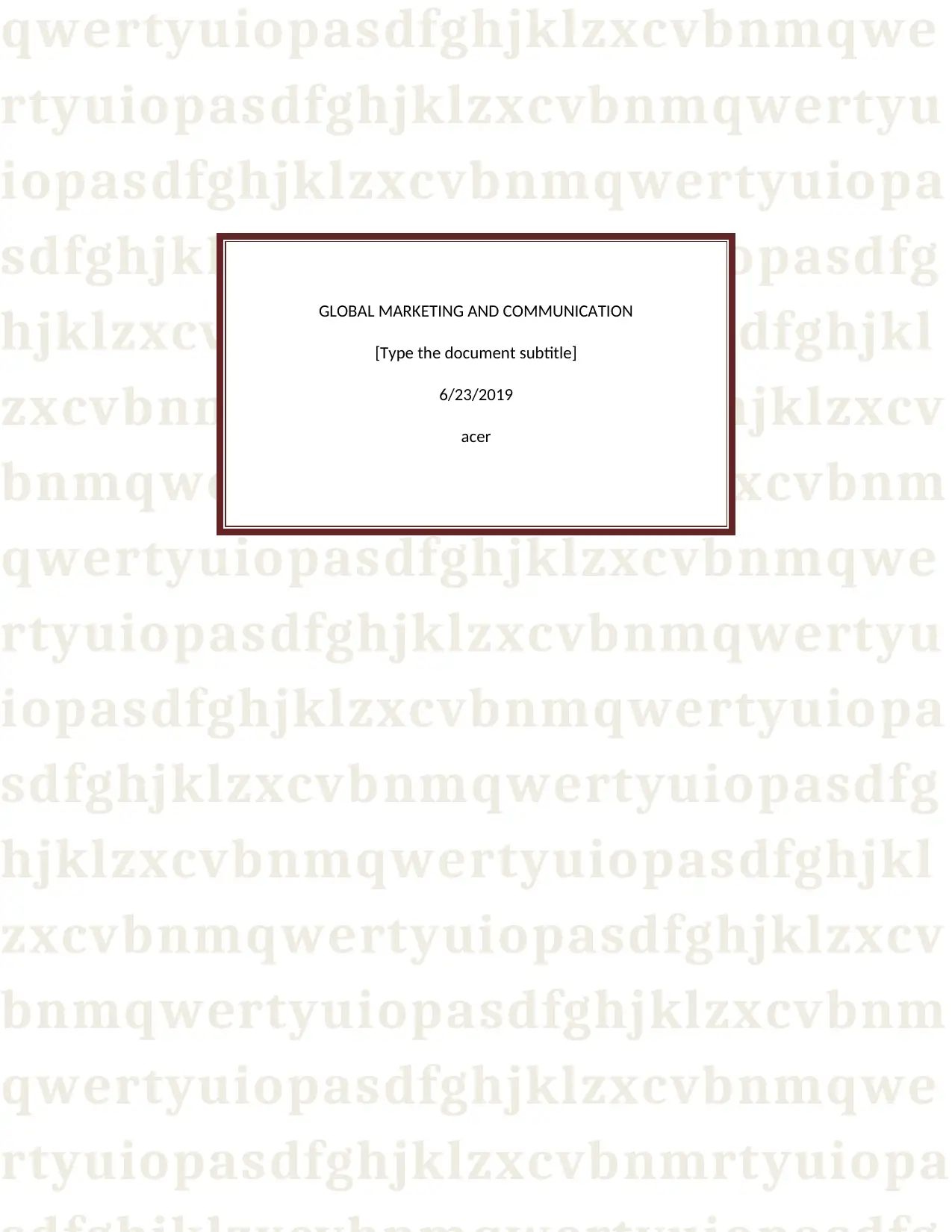
qwertyuiopasdfghjklzxcvbnmqwe
rtyuiopasdfghjklzxcvbnmqwertyu
iopasdfghjklzxcvbnmqwertyuiopa
sdfghjklzxcvbnmqwertyuiopasdfg
hjklzxcvbnmqwertyuiopasdfghjkl
zxcvbnmqwertyuiopasdfghjklzxcv
bnmqwertyuiopasdfghjklzxcvbnm
qwertyuiopasdfghjklzxcvbnmqwe
rtyuiopasdfghjklzxcvbnmqwertyu
iopasdfghjklzxcvbnmqwertyuiopa
sdfghjklzxcvbnmqwertyuiopasdfg
hjklzxcvbnmqwertyuiopasdfghjkl
zxcvbnmqwertyuiopasdfghjklzxcv
bnmqwertyuiopasdfghjklzxcvbnm
qwertyuiopasdfghjklzxcvbnmqwe
rtyuiopasdfghjklzxcvbnmrtyuiopa
GLOBAL MARKETING AND COMMUNICATION
[Type the document subtitle]
6/23/2019
acer
rtyuiopasdfghjklzxcvbnmqwertyu
iopasdfghjklzxcvbnmqwertyuiopa
sdfghjklzxcvbnmqwertyuiopasdfg
hjklzxcvbnmqwertyuiopasdfghjkl
zxcvbnmqwertyuiopasdfghjklzxcv
bnmqwertyuiopasdfghjklzxcvbnm
qwertyuiopasdfghjklzxcvbnmqwe
rtyuiopasdfghjklzxcvbnmqwertyu
iopasdfghjklzxcvbnmqwertyuiopa
sdfghjklzxcvbnmqwertyuiopasdfg
hjklzxcvbnmqwertyuiopasdfghjkl
zxcvbnmqwertyuiopasdfghjklzxcv
bnmqwertyuiopasdfghjklzxcvbnm
qwertyuiopasdfghjklzxcvbnmqwe
rtyuiopasdfghjklzxcvbnmrtyuiopa
GLOBAL MARKETING AND COMMUNICATION
[Type the document subtitle]
6/23/2019
acer
Secure Best Marks with AI Grader
Need help grading? Try our AI Grader for instant feedback on your assignments.
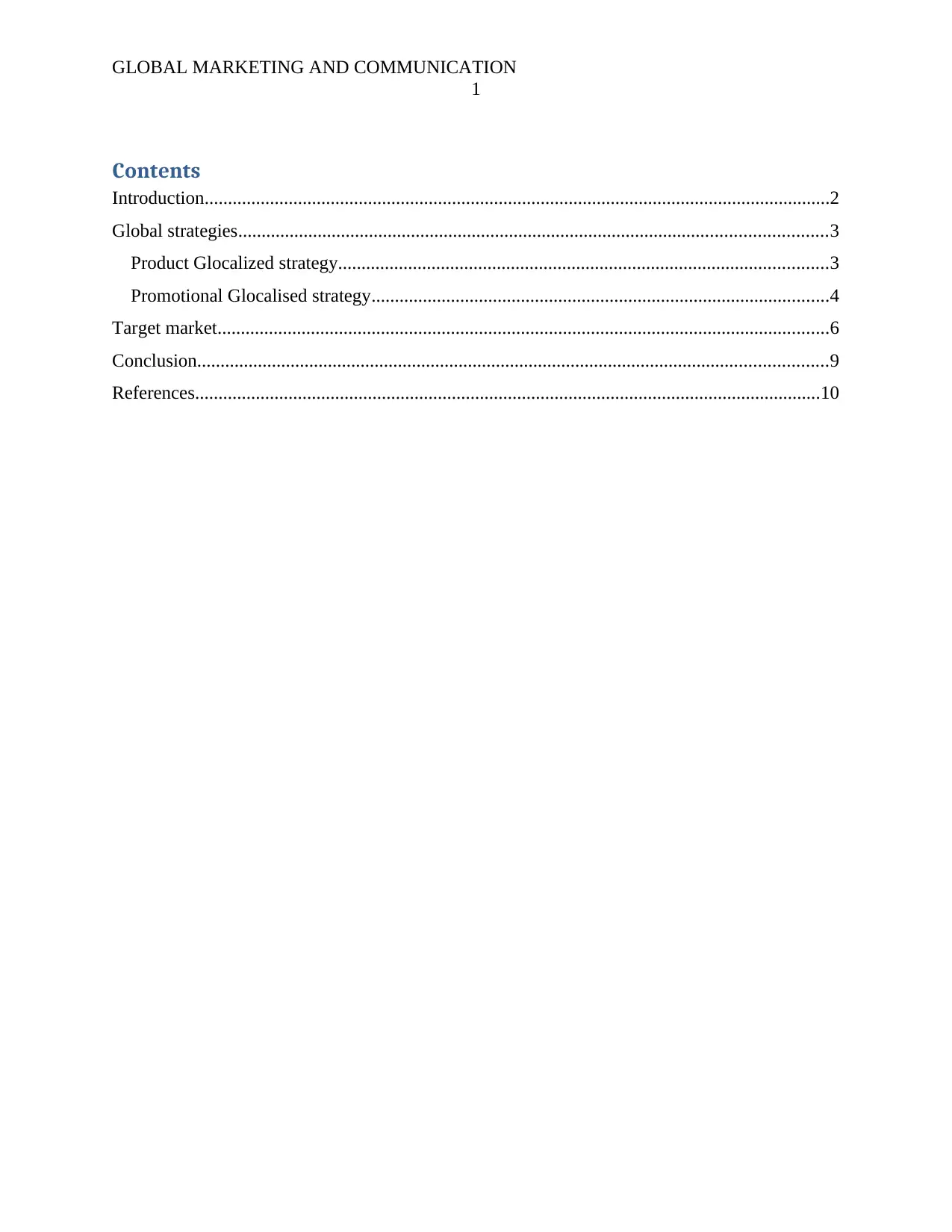
GLOBAL MARKETING AND COMMUNICATION
1
Contents
Introduction......................................................................................................................................2
Global strategies..............................................................................................................................3
Product Glocalized strategy.........................................................................................................3
Promotional Glocalised strategy..................................................................................................4
Target market...................................................................................................................................6
Conclusion.......................................................................................................................................9
References......................................................................................................................................10
1
Contents
Introduction......................................................................................................................................2
Global strategies..............................................................................................................................3
Product Glocalized strategy.........................................................................................................3
Promotional Glocalised strategy..................................................................................................4
Target market...................................................................................................................................6
Conclusion.......................................................................................................................................9
References......................................................................................................................................10
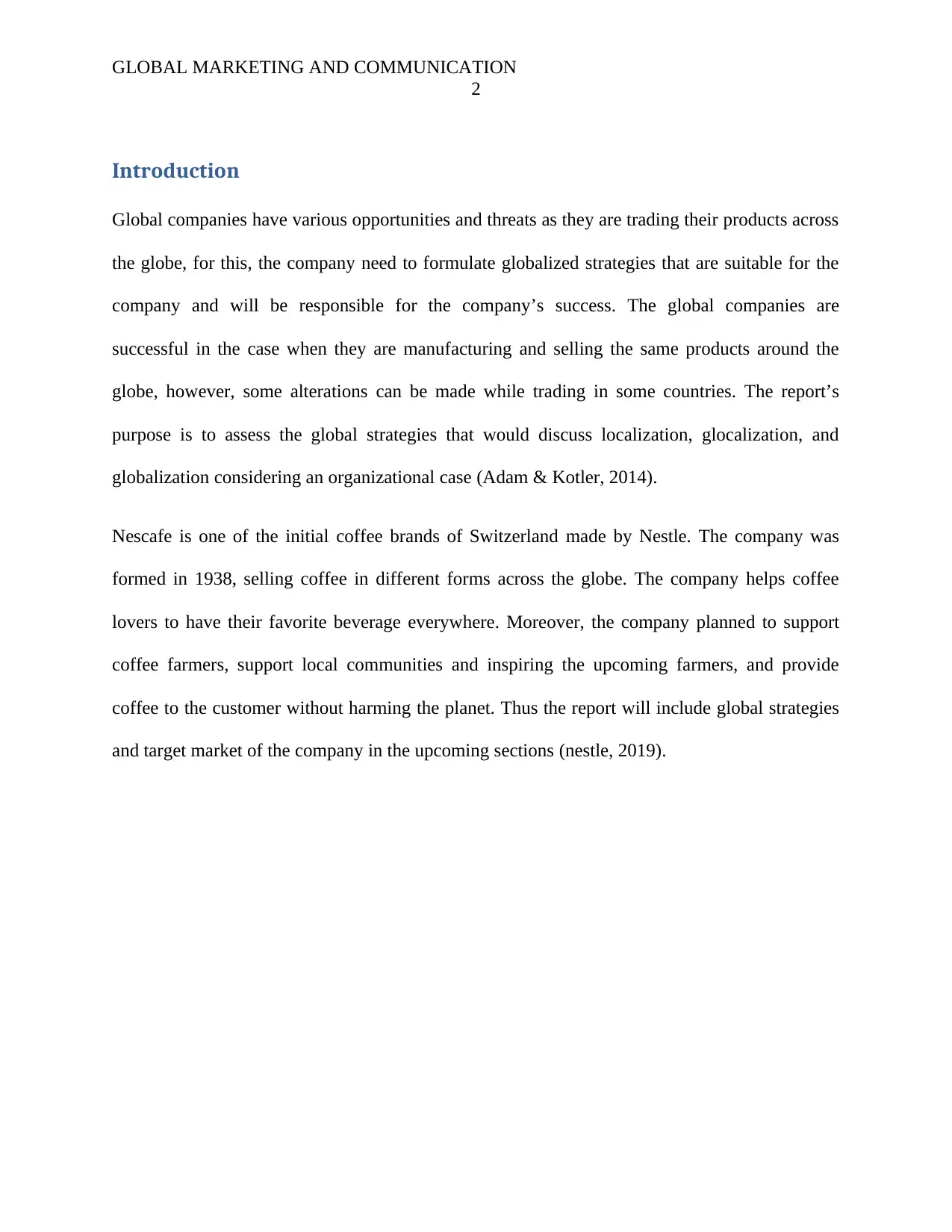
GLOBAL MARKETING AND COMMUNICATION
2
Introduction
Global companies have various opportunities and threats as they are trading their products across
the globe, for this, the company need to formulate globalized strategies that are suitable for the
company and will be responsible for the company’s success. The global companies are
successful in the case when they are manufacturing and selling the same products around the
globe, however, some alterations can be made while trading in some countries. The report’s
purpose is to assess the global strategies that would discuss localization, glocalization, and
globalization considering an organizational case (Adam & Kotler, 2014).
Nescafe is one of the initial coffee brands of Switzerland made by Nestle. The company was
formed in 1938, selling coffee in different forms across the globe. The company helps coffee
lovers to have their favorite beverage everywhere. Moreover, the company planned to support
coffee farmers, support local communities and inspiring the upcoming farmers, and provide
coffee to the customer without harming the planet. Thus the report will include global strategies
and target market of the company in the upcoming sections (nestle, 2019).
2
Introduction
Global companies have various opportunities and threats as they are trading their products across
the globe, for this, the company need to formulate globalized strategies that are suitable for the
company and will be responsible for the company’s success. The global companies are
successful in the case when they are manufacturing and selling the same products around the
globe, however, some alterations can be made while trading in some countries. The report’s
purpose is to assess the global strategies that would discuss localization, glocalization, and
globalization considering an organizational case (Adam & Kotler, 2014).
Nescafe is one of the initial coffee brands of Switzerland made by Nestle. The company was
formed in 1938, selling coffee in different forms across the globe. The company helps coffee
lovers to have their favorite beverage everywhere. Moreover, the company planned to support
coffee farmers, support local communities and inspiring the upcoming farmers, and provide
coffee to the customer without harming the planet. Thus the report will include global strategies
and target market of the company in the upcoming sections (nestle, 2019).
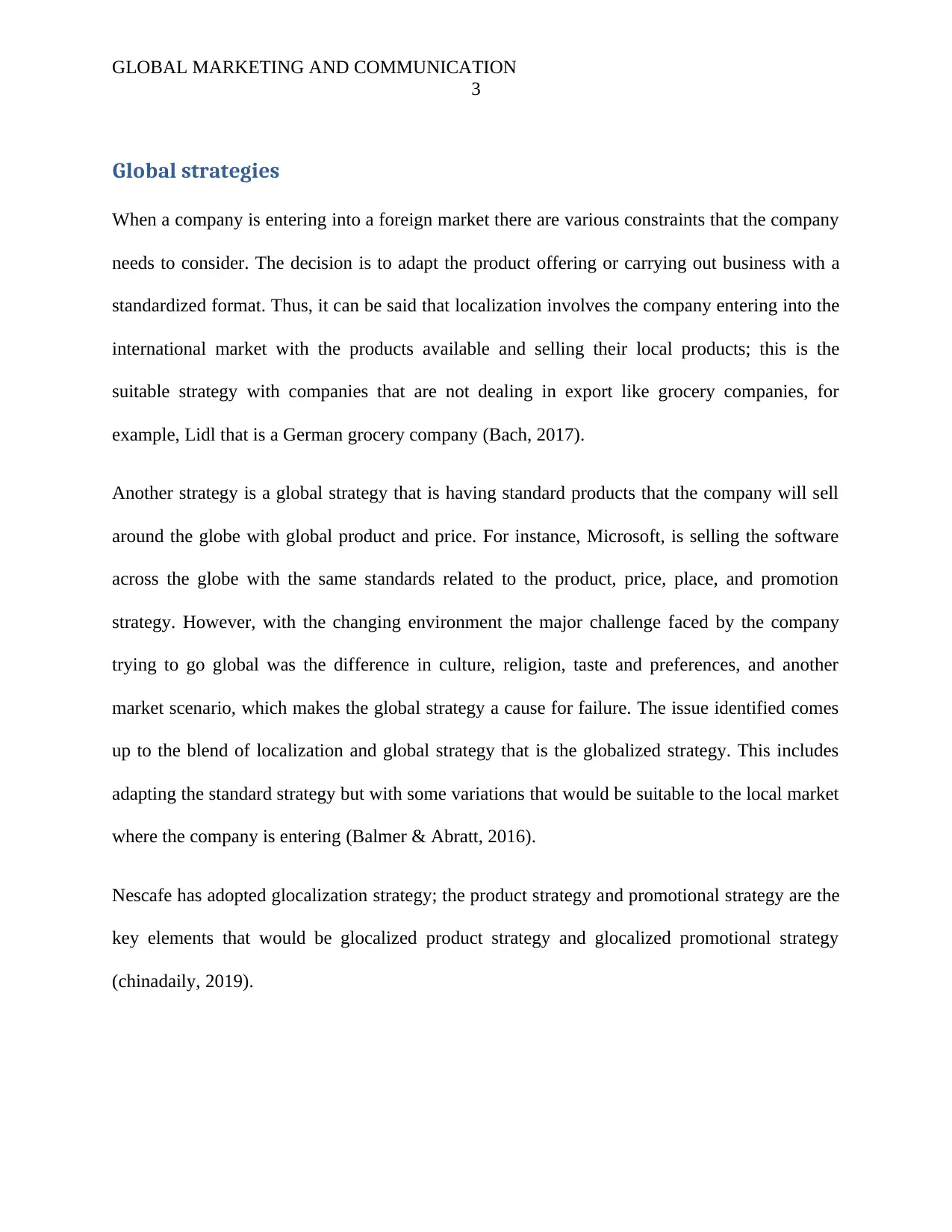
GLOBAL MARKETING AND COMMUNICATION
3
Global strategies
When a company is entering into a foreign market there are various constraints that the company
needs to consider. The decision is to adapt the product offering or carrying out business with a
standardized format. Thus, it can be said that localization involves the company entering into the
international market with the products available and selling their local products; this is the
suitable strategy with companies that are not dealing in export like grocery companies, for
example, Lidl that is a German grocery company (Bach, 2017).
Another strategy is a global strategy that is having standard products that the company will sell
around the globe with global product and price. For instance, Microsoft, is selling the software
across the globe with the same standards related to the product, price, place, and promotion
strategy. However, with the changing environment the major challenge faced by the company
trying to go global was the difference in culture, religion, taste and preferences, and another
market scenario, which makes the global strategy a cause for failure. The issue identified comes
up to the blend of localization and global strategy that is the globalized strategy. This includes
adapting the standard strategy but with some variations that would be suitable to the local market
where the company is entering (Balmer & Abratt, 2016).
Nescafe has adopted glocalization strategy; the product strategy and promotional strategy are the
key elements that would be glocalized product strategy and glocalized promotional strategy
(chinadaily, 2019).
3
Global strategies
When a company is entering into a foreign market there are various constraints that the company
needs to consider. The decision is to adapt the product offering or carrying out business with a
standardized format. Thus, it can be said that localization involves the company entering into the
international market with the products available and selling their local products; this is the
suitable strategy with companies that are not dealing in export like grocery companies, for
example, Lidl that is a German grocery company (Bach, 2017).
Another strategy is a global strategy that is having standard products that the company will sell
around the globe with global product and price. For instance, Microsoft, is selling the software
across the globe with the same standards related to the product, price, place, and promotion
strategy. However, with the changing environment the major challenge faced by the company
trying to go global was the difference in culture, religion, taste and preferences, and another
market scenario, which makes the global strategy a cause for failure. The issue identified comes
up to the blend of localization and global strategy that is the globalized strategy. This includes
adapting the standard strategy but with some variations that would be suitable to the local market
where the company is entering (Balmer & Abratt, 2016).
Nescafe has adopted glocalization strategy; the product strategy and promotional strategy are the
key elements that would be glocalized product strategy and glocalized promotional strategy
(chinadaily, 2019).
Secure Best Marks with AI Grader
Need help grading? Try our AI Grader for instant feedback on your assignments.
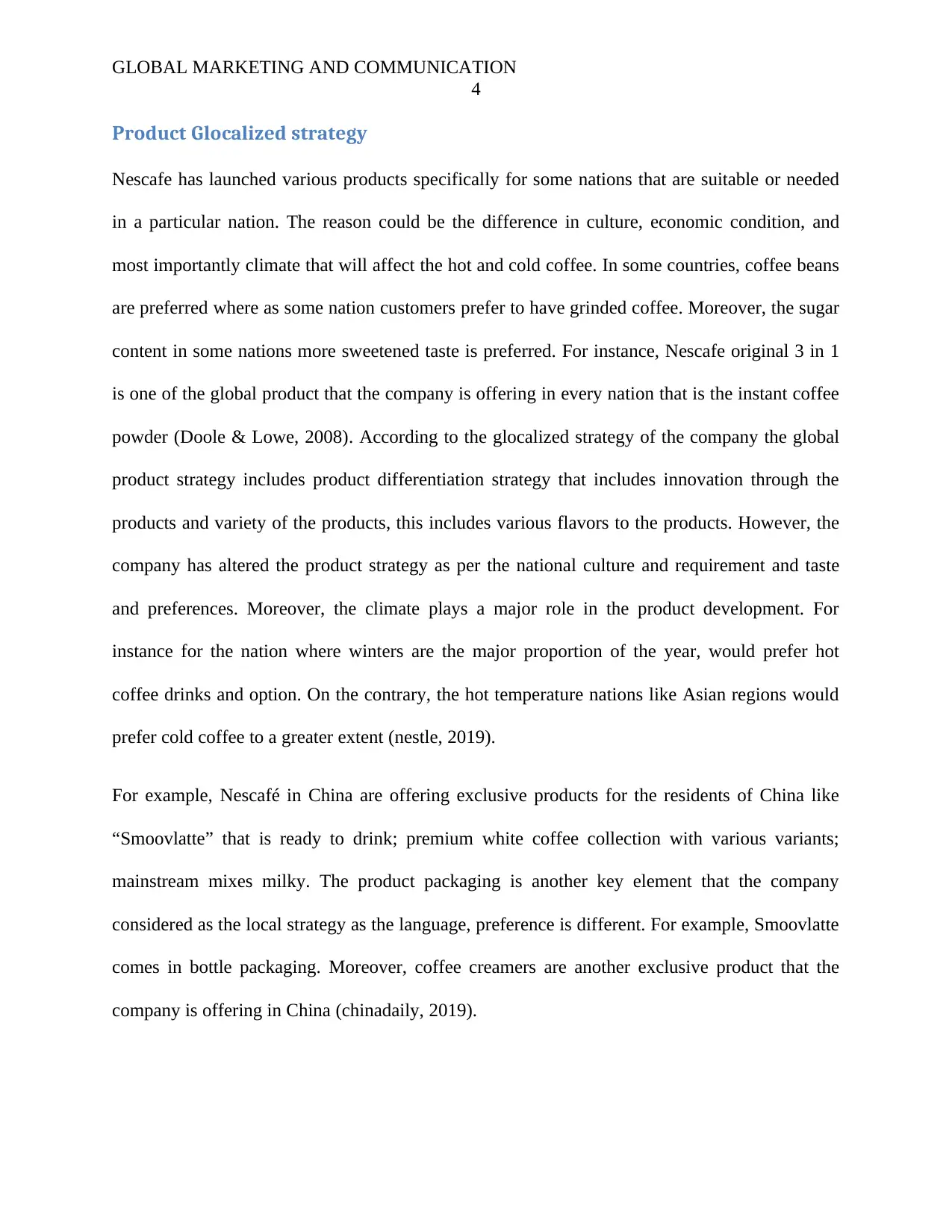
GLOBAL MARKETING AND COMMUNICATION
4
Product Glocalized strategy
Nescafe has launched various products specifically for some nations that are suitable or needed
in a particular nation. The reason could be the difference in culture, economic condition, and
most importantly climate that will affect the hot and cold coffee. In some countries, coffee beans
are preferred where as some nation customers prefer to have grinded coffee. Moreover, the sugar
content in some nations more sweetened taste is preferred. For instance, Nescafe original 3 in 1
is one of the global product that the company is offering in every nation that is the instant coffee
powder (Doole & Lowe, 2008). According to the glocalized strategy of the company the global
product strategy includes product differentiation strategy that includes innovation through the
products and variety of the products, this includes various flavors to the products. However, the
company has altered the product strategy as per the national culture and requirement and taste
and preferences. Moreover, the climate plays a major role in the product development. For
instance for the nation where winters are the major proportion of the year, would prefer hot
coffee drinks and option. On the contrary, the hot temperature nations like Asian regions would
prefer cold coffee to a greater extent (nestle, 2019).
For example, Nescafé in China are offering exclusive products for the residents of China like
“Smoovlatte” that is ready to drink; premium white coffee collection with various variants;
mainstream mixes milky. The product packaging is another key element that the company
considered as the local strategy as the language, preference is different. For example, Smoovlatte
comes in bottle packaging. Moreover, coffee creamers are another exclusive product that the
company is offering in China (chinadaily, 2019).
4
Product Glocalized strategy
Nescafe has launched various products specifically for some nations that are suitable or needed
in a particular nation. The reason could be the difference in culture, economic condition, and
most importantly climate that will affect the hot and cold coffee. In some countries, coffee beans
are preferred where as some nation customers prefer to have grinded coffee. Moreover, the sugar
content in some nations more sweetened taste is preferred. For instance, Nescafe original 3 in 1
is one of the global product that the company is offering in every nation that is the instant coffee
powder (Doole & Lowe, 2008). According to the glocalized strategy of the company the global
product strategy includes product differentiation strategy that includes innovation through the
products and variety of the products, this includes various flavors to the products. However, the
company has altered the product strategy as per the national culture and requirement and taste
and preferences. Moreover, the climate plays a major role in the product development. For
instance for the nation where winters are the major proportion of the year, would prefer hot
coffee drinks and option. On the contrary, the hot temperature nations like Asian regions would
prefer cold coffee to a greater extent (nestle, 2019).
For example, Nescafé in China are offering exclusive products for the residents of China like
“Smoovlatte” that is ready to drink; premium white coffee collection with various variants;
mainstream mixes milky. The product packaging is another key element that the company
considered as the local strategy as the language, preference is different. For example, Smoovlatte
comes in bottle packaging. Moreover, coffee creamers are another exclusive product that the
company is offering in China (chinadaily, 2019).
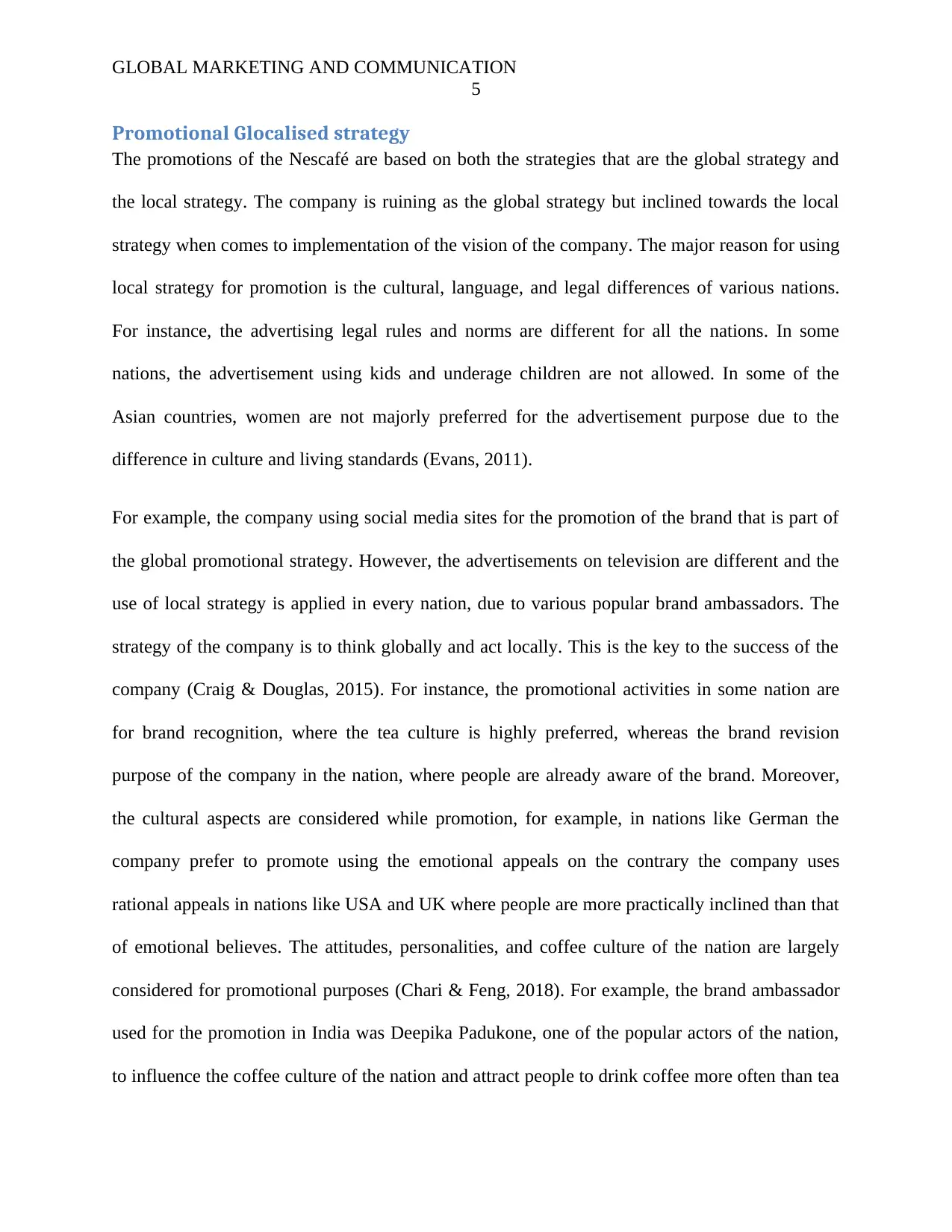
GLOBAL MARKETING AND COMMUNICATION
5
Promotional Glocalised strategy
The promotions of the Nescafé are based on both the strategies that are the global strategy and
the local strategy. The company is ruining as the global strategy but inclined towards the local
strategy when comes to implementation of the vision of the company. The major reason for using
local strategy for promotion is the cultural, language, and legal differences of various nations.
For instance, the advertising legal rules and norms are different for all the nations. In some
nations, the advertisement using kids and underage children are not allowed. In some of the
Asian countries, women are not majorly preferred for the advertisement purpose due to the
difference in culture and living standards (Evans, 2011).
For example, the company using social media sites for the promotion of the brand that is part of
the global promotional strategy. However, the advertisements on television are different and the
use of local strategy is applied in every nation, due to various popular brand ambassadors. The
strategy of the company is to think globally and act locally. This is the key to the success of the
company (Craig & Douglas, 2015). For instance, the promotional activities in some nation are
for brand recognition, where the tea culture is highly preferred, whereas the brand revision
purpose of the company in the nation, where people are already aware of the brand. Moreover,
the cultural aspects are considered while promotion, for example, in nations like German the
company prefer to promote using the emotional appeals on the contrary the company uses
rational appeals in nations like USA and UK where people are more practically inclined than that
of emotional believes. The attitudes, personalities, and coffee culture of the nation are largely
considered for promotional purposes (Chari & Feng, 2018). For example, the brand ambassador
used for the promotion in India was Deepika Padukone, one of the popular actors of the nation,
to influence the coffee culture of the nation and attract people to drink coffee more often than tea
5
Promotional Glocalised strategy
The promotions of the Nescafé are based on both the strategies that are the global strategy and
the local strategy. The company is ruining as the global strategy but inclined towards the local
strategy when comes to implementation of the vision of the company. The major reason for using
local strategy for promotion is the cultural, language, and legal differences of various nations.
For instance, the advertising legal rules and norms are different for all the nations. In some
nations, the advertisement using kids and underage children are not allowed. In some of the
Asian countries, women are not majorly preferred for the advertisement purpose due to the
difference in culture and living standards (Evans, 2011).
For example, the company using social media sites for the promotion of the brand that is part of
the global promotional strategy. However, the advertisements on television are different and the
use of local strategy is applied in every nation, due to various popular brand ambassadors. The
strategy of the company is to think globally and act locally. This is the key to the success of the
company (Craig & Douglas, 2015). For instance, the promotional activities in some nation are
for brand recognition, where the tea culture is highly preferred, whereas the brand revision
purpose of the company in the nation, where people are already aware of the brand. Moreover,
the cultural aspects are considered while promotion, for example, in nations like German the
company prefer to promote using the emotional appeals on the contrary the company uses
rational appeals in nations like USA and UK where people are more practically inclined than that
of emotional believes. The attitudes, personalities, and coffee culture of the nation are largely
considered for promotional purposes (Chari & Feng, 2018). For example, the brand ambassador
used for the promotion in India was Deepika Padukone, one of the popular actors of the nation,
to influence the coffee culture of the nation and attract people to drink coffee more often than tea
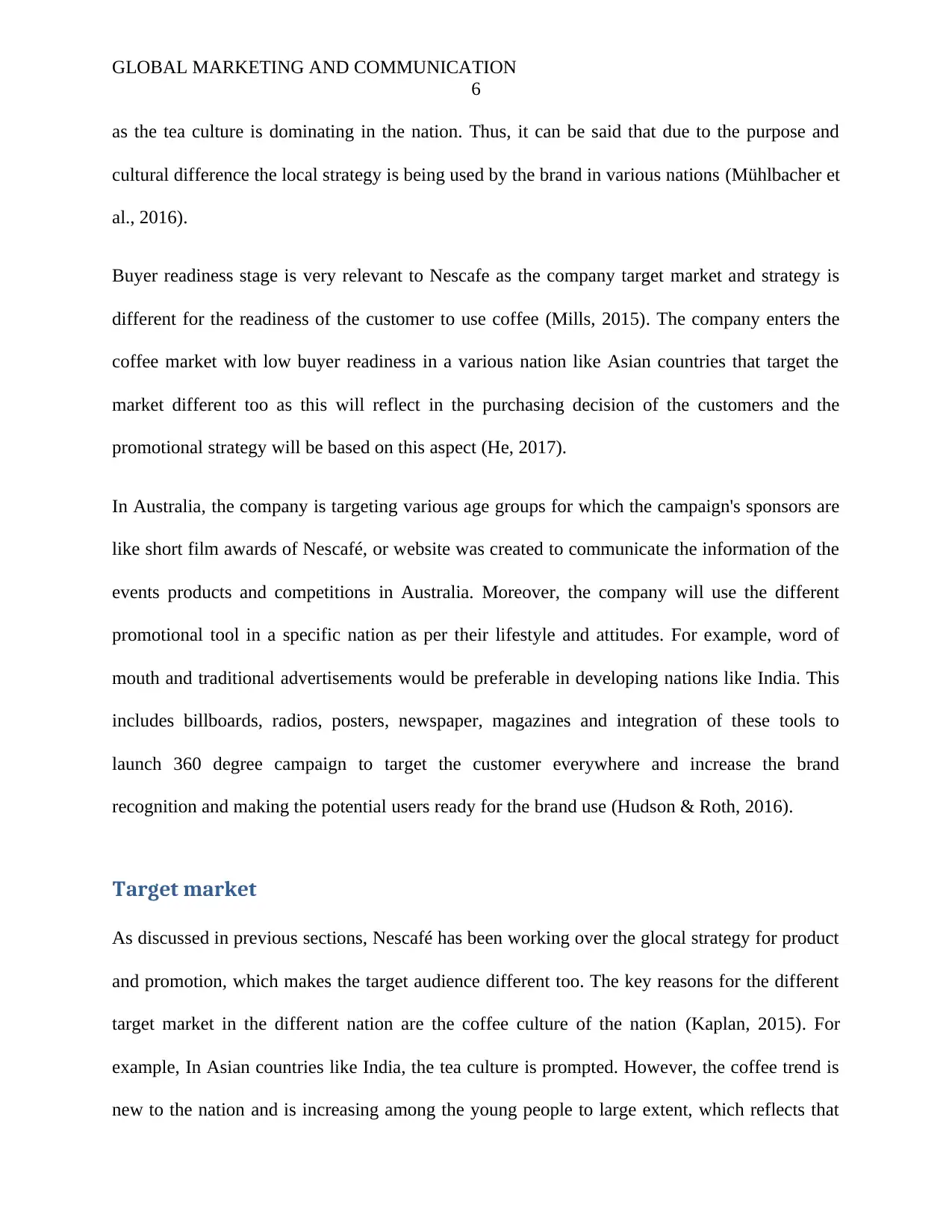
GLOBAL MARKETING AND COMMUNICATION
6
as the tea culture is dominating in the nation. Thus, it can be said that due to the purpose and
cultural difference the local strategy is being used by the brand in various nations (Mühlbacher et
al., 2016).
Buyer readiness stage is very relevant to Nescafe as the company target market and strategy is
different for the readiness of the customer to use coffee (Mills, 2015). The company enters the
coffee market with low buyer readiness in a various nation like Asian countries that target the
market different too as this will reflect in the purchasing decision of the customers and the
promotional strategy will be based on this aspect (He, 2017).
In Australia, the company is targeting various age groups for which the campaign's sponsors are
like short film awards of Nescafé, or website was created to communicate the information of the
events products and competitions in Australia. Moreover, the company will use the different
promotional tool in a specific nation as per their lifestyle and attitudes. For example, word of
mouth and traditional advertisements would be preferable in developing nations like India. This
includes billboards, radios, posters, newspaper, magazines and integration of these tools to
launch 360 degree campaign to target the customer everywhere and increase the brand
recognition and making the potential users ready for the brand use (Hudson & Roth, 2016).
Target market
As discussed in previous sections, Nescafé has been working over the glocal strategy for product
and promotion, which makes the target audience different too. The key reasons for the different
target market in the different nation are the coffee culture of the nation (Kaplan, 2015). For
example, In Asian countries like India, the tea culture is prompted. However, the coffee trend is
new to the nation and is increasing among the young people to large extent, which reflects that
6
as the tea culture is dominating in the nation. Thus, it can be said that due to the purpose and
cultural difference the local strategy is being used by the brand in various nations (Mühlbacher et
al., 2016).
Buyer readiness stage is very relevant to Nescafe as the company target market and strategy is
different for the readiness of the customer to use coffee (Mills, 2015). The company enters the
coffee market with low buyer readiness in a various nation like Asian countries that target the
market different too as this will reflect in the purchasing decision of the customers and the
promotional strategy will be based on this aspect (He, 2017).
In Australia, the company is targeting various age groups for which the campaign's sponsors are
like short film awards of Nescafé, or website was created to communicate the information of the
events products and competitions in Australia. Moreover, the company will use the different
promotional tool in a specific nation as per their lifestyle and attitudes. For example, word of
mouth and traditional advertisements would be preferable in developing nations like India. This
includes billboards, radios, posters, newspaper, magazines and integration of these tools to
launch 360 degree campaign to target the customer everywhere and increase the brand
recognition and making the potential users ready for the brand use (Hudson & Roth, 2016).
Target market
As discussed in previous sections, Nescafé has been working over the glocal strategy for product
and promotion, which makes the target audience different too. The key reasons for the different
target market in the different nation are the coffee culture of the nation (Kaplan, 2015). For
example, In Asian countries like India, the tea culture is prompted. However, the coffee trend is
new to the nation and is increasing among the young people to large extent, which reflects that
Paraphrase This Document
Need a fresh take? Get an instant paraphrase of this document with our AI Paraphraser
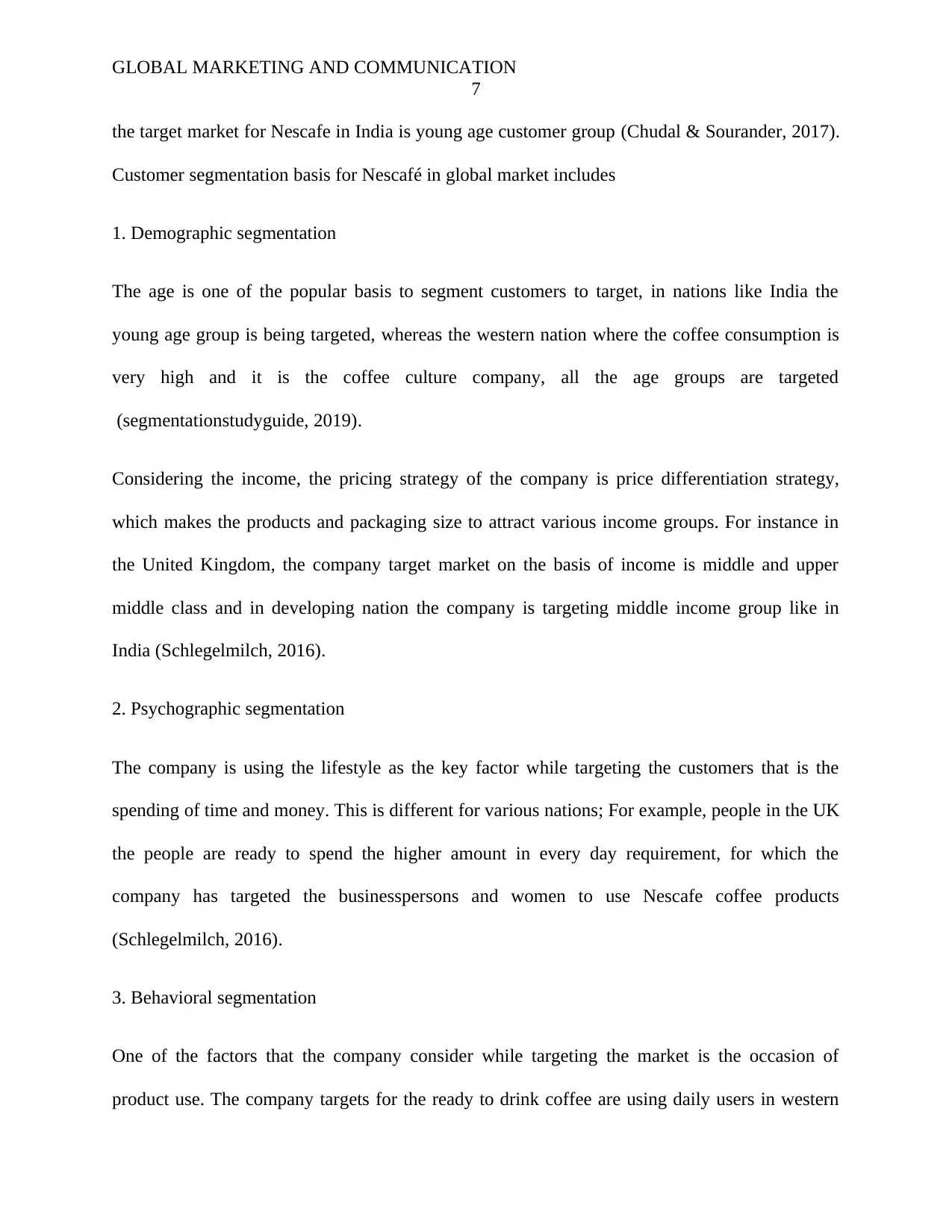
GLOBAL MARKETING AND COMMUNICATION
7
the target market for Nescafe in India is young age customer group (Chudal & Sourander, 2017).
Customer segmentation basis for Nescafé in global market includes
1. Demographic segmentation
The age is one of the popular basis to segment customers to target, in nations like India the
young age group is being targeted, whereas the western nation where the coffee consumption is
very high and it is the coffee culture company, all the age groups are targeted
(segmentationstudyguide, 2019).
Considering the income, the pricing strategy of the company is price differentiation strategy,
which makes the products and packaging size to attract various income groups. For instance in
the United Kingdom, the company target market on the basis of income is middle and upper
middle class and in developing nation the company is targeting middle income group like in
India (Schlegelmilch, 2016).
2. Psychographic segmentation
The company is using the lifestyle as the key factor while targeting the customers that is the
spending of time and money. This is different for various nations; For example, people in the UK
the people are ready to spend the higher amount in every day requirement, for which the
company has targeted the businesspersons and women to use Nescafe coffee products
(Schlegelmilch, 2016).
3. Behavioral segmentation
One of the factors that the company consider while targeting the market is the occasion of
product use. The company targets for the ready to drink coffee are using daily users in western
7
the target market for Nescafe in India is young age customer group (Chudal & Sourander, 2017).
Customer segmentation basis for Nescafé in global market includes
1. Demographic segmentation
The age is one of the popular basis to segment customers to target, in nations like India the
young age group is being targeted, whereas the western nation where the coffee consumption is
very high and it is the coffee culture company, all the age groups are targeted
(segmentationstudyguide, 2019).
Considering the income, the pricing strategy of the company is price differentiation strategy,
which makes the products and packaging size to attract various income groups. For instance in
the United Kingdom, the company target market on the basis of income is middle and upper
middle class and in developing nation the company is targeting middle income group like in
India (Schlegelmilch, 2016).
2. Psychographic segmentation
The company is using the lifestyle as the key factor while targeting the customers that is the
spending of time and money. This is different for various nations; For example, people in the UK
the people are ready to spend the higher amount in every day requirement, for which the
company has targeted the businesspersons and women to use Nescafe coffee products
(Schlegelmilch, 2016).
3. Behavioral segmentation
One of the factors that the company consider while targeting the market is the occasion of
product use. The company targets for the ready to drink coffee are using daily users in western
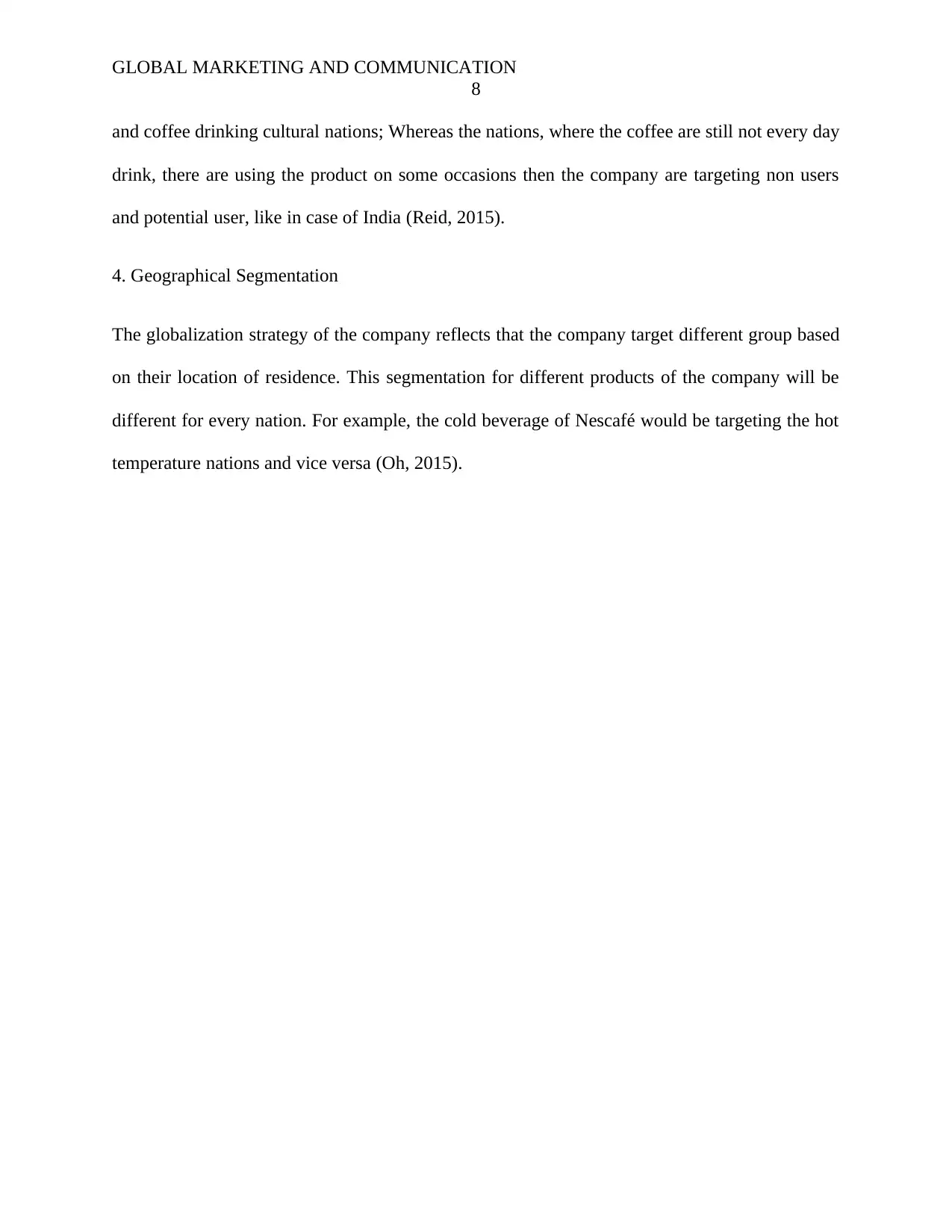
GLOBAL MARKETING AND COMMUNICATION
8
and coffee drinking cultural nations; Whereas the nations, where the coffee are still not every day
drink, there are using the product on some occasions then the company are targeting non users
and potential user, like in case of India (Reid, 2015).
4. Geographical Segmentation
The globalization strategy of the company reflects that the company target different group based
on their location of residence. This segmentation for different products of the company will be
different for every nation. For example, the cold beverage of Nescafé would be targeting the hot
temperature nations and vice versa (Oh, 2015).
8
and coffee drinking cultural nations; Whereas the nations, where the coffee are still not every day
drink, there are using the product on some occasions then the company are targeting non users
and potential user, like in case of India (Reid, 2015).
4. Geographical Segmentation
The globalization strategy of the company reflects that the company target different group based
on their location of residence. This segmentation for different products of the company will be
different for every nation. For example, the cold beverage of Nescafé would be targeting the hot
temperature nations and vice versa (Oh, 2015).
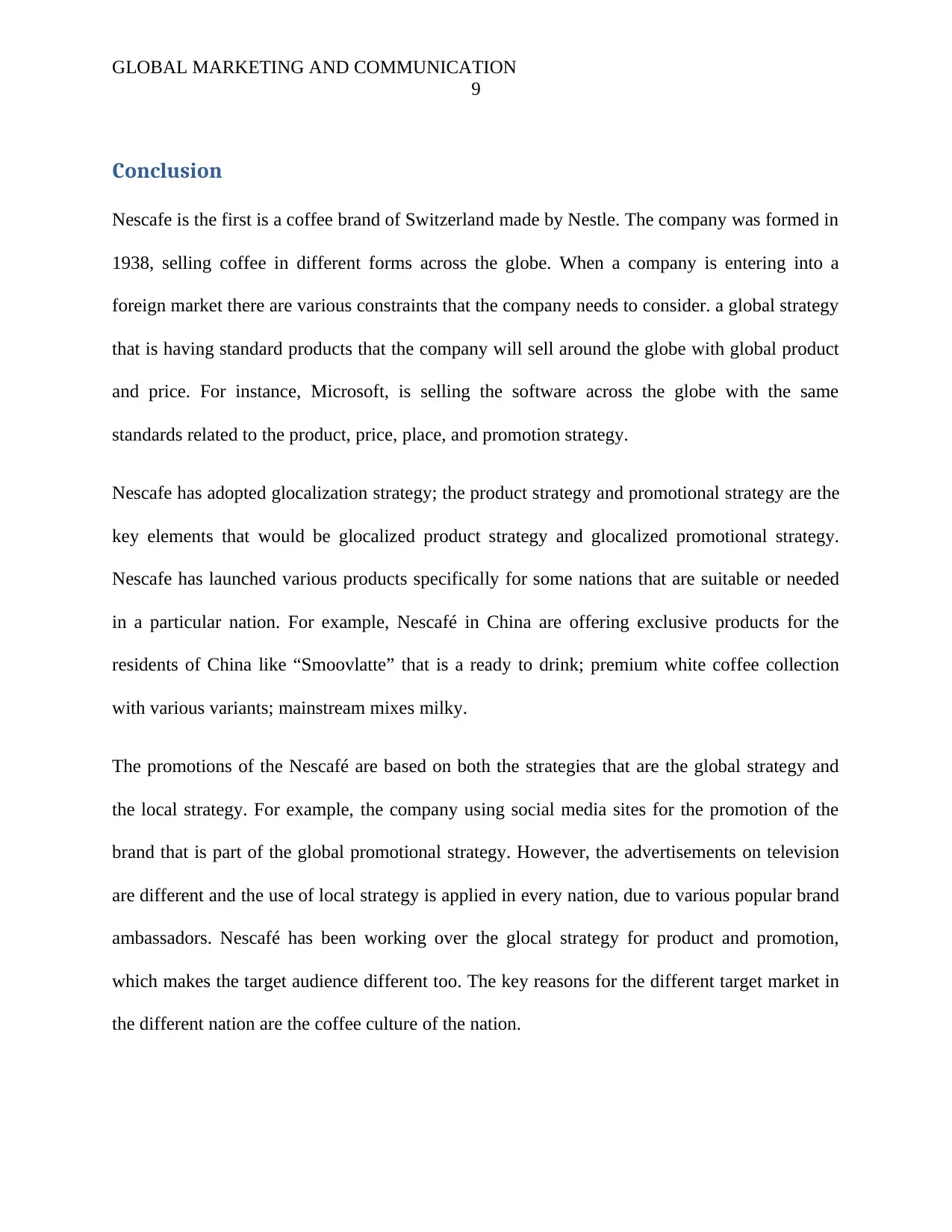
GLOBAL MARKETING AND COMMUNICATION
9
Conclusion
Nescafe is the first is a coffee brand of Switzerland made by Nestle. The company was formed in
1938, selling coffee in different forms across the globe. When a company is entering into a
foreign market there are various constraints that the company needs to consider. a global strategy
that is having standard products that the company will sell around the globe with global product
and price. For instance, Microsoft, is selling the software across the globe with the same
standards related to the product, price, place, and promotion strategy.
Nescafe has adopted glocalization strategy; the product strategy and promotional strategy are the
key elements that would be glocalized product strategy and glocalized promotional strategy.
Nescafe has launched various products specifically for some nations that are suitable or needed
in a particular nation. For example, Nescafé in China are offering exclusive products for the
residents of China like “Smoovlatte” that is a ready to drink; premium white coffee collection
with various variants; mainstream mixes milky.
The promotions of the Nescafé are based on both the strategies that are the global strategy and
the local strategy. For example, the company using social media sites for the promotion of the
brand that is part of the global promotional strategy. However, the advertisements on television
are different and the use of local strategy is applied in every nation, due to various popular brand
ambassadors. Nescafé has been working over the glocal strategy for product and promotion,
which makes the target audience different too. The key reasons for the different target market in
the different nation are the coffee culture of the nation.
9
Conclusion
Nescafe is the first is a coffee brand of Switzerland made by Nestle. The company was formed in
1938, selling coffee in different forms across the globe. When a company is entering into a
foreign market there are various constraints that the company needs to consider. a global strategy
that is having standard products that the company will sell around the globe with global product
and price. For instance, Microsoft, is selling the software across the globe with the same
standards related to the product, price, place, and promotion strategy.
Nescafe has adopted glocalization strategy; the product strategy and promotional strategy are the
key elements that would be glocalized product strategy and glocalized promotional strategy.
Nescafe has launched various products specifically for some nations that are suitable or needed
in a particular nation. For example, Nescafé in China are offering exclusive products for the
residents of China like “Smoovlatte” that is a ready to drink; premium white coffee collection
with various variants; mainstream mixes milky.
The promotions of the Nescafé are based on both the strategies that are the global strategy and
the local strategy. For example, the company using social media sites for the promotion of the
brand that is part of the global promotional strategy. However, the advertisements on television
are different and the use of local strategy is applied in every nation, due to various popular brand
ambassadors. Nescafé has been working over the glocal strategy for product and promotion,
which makes the target audience different too. The key reasons for the different target market in
the different nation are the coffee culture of the nation.
Secure Best Marks with AI Grader
Need help grading? Try our AI Grader for instant feedback on your assignments.
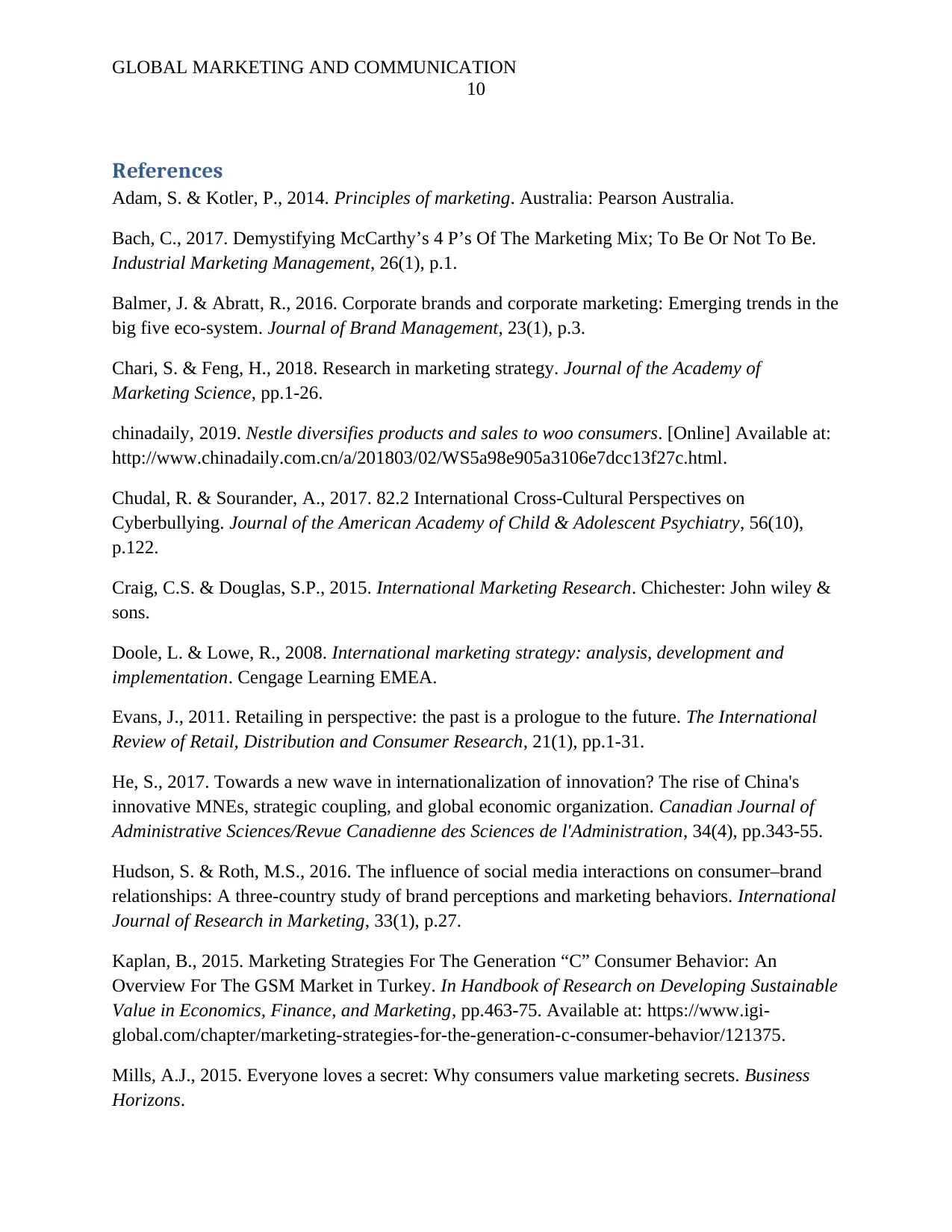
GLOBAL MARKETING AND COMMUNICATION
10
References
Adam, S. & Kotler, P., 2014. Principles of marketing. Australia: Pearson Australia.
Bach, C., 2017. Demystifying McCarthy’s 4 P’s Of The Marketing Mix; To Be Or Not To Be.
Industrial Marketing Management, 26(1), p.1.
Balmer, J. & Abratt, R., 2016. Corporate brands and corporate marketing: Emerging trends in the
big five eco-system. Journal of Brand Management, 23(1), p.3.
Chari, S. & Feng, H., 2018. Research in marketing strategy. Journal of the Academy of
Marketing Science, pp.1-26.
chinadaily, 2019. Nestle diversifies products and sales to woo consumers. [Online] Available at:
http://www.chinadaily.com.cn/a/201803/02/WS5a98e905a3106e7dcc13f27c.html.
Chudal, R. & Sourander, A., 2017. 82.2 International Cross-Cultural Perspectives on
Cyberbullying. Journal of the American Academy of Child & Adolescent Psychiatry, 56(10),
p.122.
Craig, C.S. & Douglas, S.P., 2015. International Marketing Research. Chichester: John wiley &
sons.
Doole, L. & Lowe, R., 2008. International marketing strategy: analysis, development and
implementation. Cengage Learning EMEA.
Evans, J., 2011. Retailing in perspective: the past is a prologue to the future. The International
Review of Retail, Distribution and Consumer Research, 21(1), pp.1-31.
He, S., 2017. Towards a new wave in internationalization of innovation? The rise of China's
innovative MNEs, strategic coupling, and global economic organization. Canadian Journal of
Administrative Sciences/Revue Canadienne des Sciences de l'Administration, 34(4), pp.343-55.
Hudson, S. & Roth, M.S., 2016. The influence of social media interactions on consumer–brand
relationships: A three-country study of brand perceptions and marketing behaviors. International
Journal of Research in Marketing, 33(1), p.27.
Kaplan, B., 2015. Marketing Strategies For The Generation “C” Consumer Behavior: An
Overview For The GSM Market in Turkey. In Handbook of Research on Developing Sustainable
Value in Economics, Finance, and Marketing, pp.463-75. Available at: https://www.igi-
global.com/chapter/marketing-strategies-for-the-generation-c-consumer-behavior/121375.
Mills, A.J., 2015. Everyone loves a secret: Why consumers value marketing secrets. Business
Horizons.
10
References
Adam, S. & Kotler, P., 2014. Principles of marketing. Australia: Pearson Australia.
Bach, C., 2017. Demystifying McCarthy’s 4 P’s Of The Marketing Mix; To Be Or Not To Be.
Industrial Marketing Management, 26(1), p.1.
Balmer, J. & Abratt, R., 2016. Corporate brands and corporate marketing: Emerging trends in the
big five eco-system. Journal of Brand Management, 23(1), p.3.
Chari, S. & Feng, H., 2018. Research in marketing strategy. Journal of the Academy of
Marketing Science, pp.1-26.
chinadaily, 2019. Nestle diversifies products and sales to woo consumers. [Online] Available at:
http://www.chinadaily.com.cn/a/201803/02/WS5a98e905a3106e7dcc13f27c.html.
Chudal, R. & Sourander, A., 2017. 82.2 International Cross-Cultural Perspectives on
Cyberbullying. Journal of the American Academy of Child & Adolescent Psychiatry, 56(10),
p.122.
Craig, C.S. & Douglas, S.P., 2015. International Marketing Research. Chichester: John wiley &
sons.
Doole, L. & Lowe, R., 2008. International marketing strategy: analysis, development and
implementation. Cengage Learning EMEA.
Evans, J., 2011. Retailing in perspective: the past is a prologue to the future. The International
Review of Retail, Distribution and Consumer Research, 21(1), pp.1-31.
He, S., 2017. Towards a new wave in internationalization of innovation? The rise of China's
innovative MNEs, strategic coupling, and global economic organization. Canadian Journal of
Administrative Sciences/Revue Canadienne des Sciences de l'Administration, 34(4), pp.343-55.
Hudson, S. & Roth, M.S., 2016. The influence of social media interactions on consumer–brand
relationships: A three-country study of brand perceptions and marketing behaviors. International
Journal of Research in Marketing, 33(1), p.27.
Kaplan, B., 2015. Marketing Strategies For The Generation “C” Consumer Behavior: An
Overview For The GSM Market in Turkey. In Handbook of Research on Developing Sustainable
Value in Economics, Finance, and Marketing, pp.463-75. Available at: https://www.igi-
global.com/chapter/marketing-strategies-for-the-generation-c-consumer-behavior/121375.
Mills, A.J., 2015. Everyone loves a secret: Why consumers value marketing secrets. Business
Horizons.
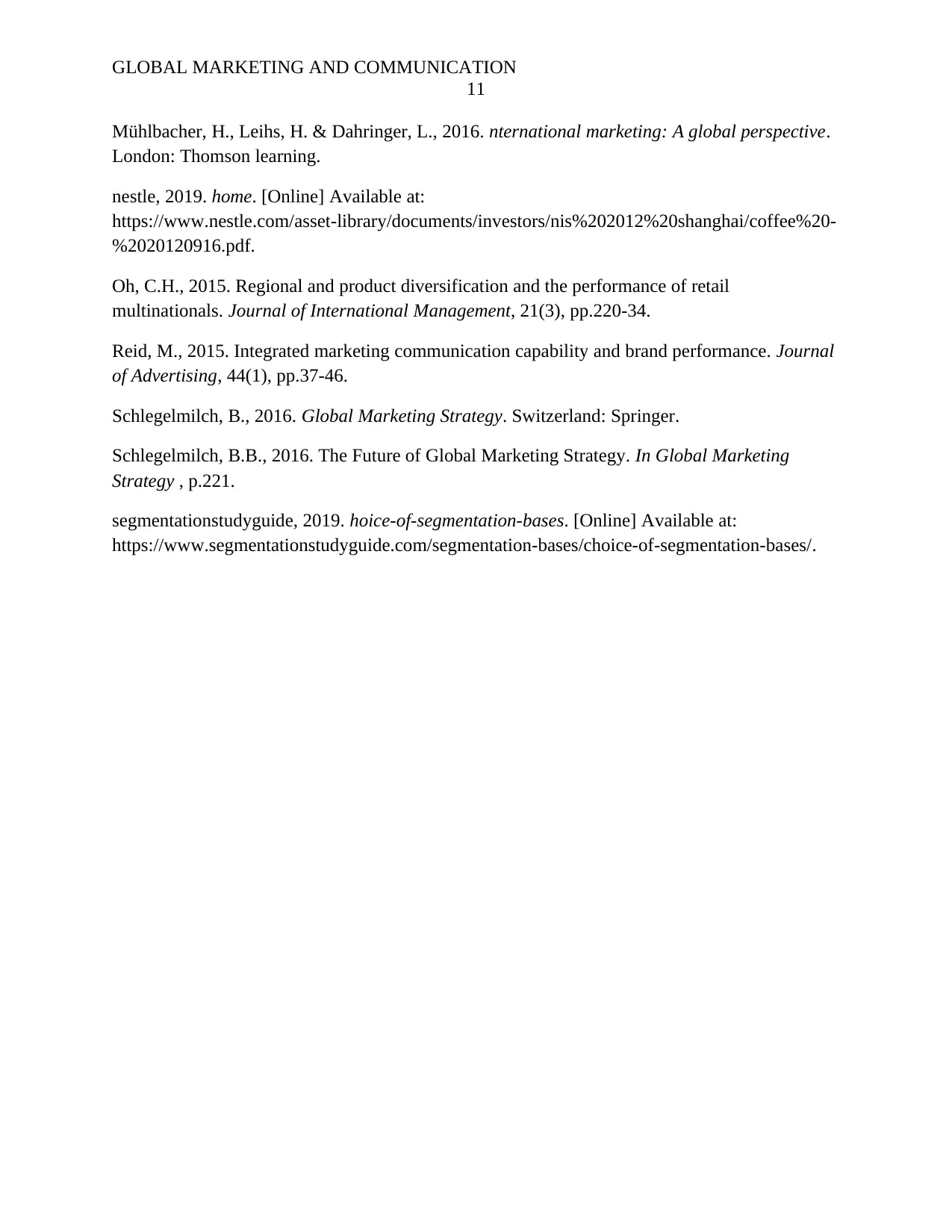
GLOBAL MARKETING AND COMMUNICATION
11
Mühlbacher, H., Leihs, H. & Dahringer, L., 2016. nternational marketing: A global perspective.
London: Thomson learning.
nestle, 2019. home. [Online] Available at:
https://www.nestle.com/asset-library/documents/investors/nis%202012%20shanghai/coffee%20-
%2020120916.pdf.
Oh, C.H., 2015. Regional and product diversification and the performance of retail
multinationals. Journal of International Management, 21(3), pp.220-34.
Reid, M., 2015. Integrated marketing communication capability and brand performance. Journal
of Advertising, 44(1), pp.37-46.
Schlegelmilch, B., 2016. Global Marketing Strategy. Switzerland: Springer.
Schlegelmilch, B.B., 2016. The Future of Global Marketing Strategy. In Global Marketing
Strategy , p.221.
segmentationstudyguide, 2019. hoice-of-segmentation-bases. [Online] Available at:
https://www.segmentationstudyguide.com/segmentation-bases/choice-of-segmentation-bases/.
11
Mühlbacher, H., Leihs, H. & Dahringer, L., 2016. nternational marketing: A global perspective.
London: Thomson learning.
nestle, 2019. home. [Online] Available at:
https://www.nestle.com/asset-library/documents/investors/nis%202012%20shanghai/coffee%20-
%2020120916.pdf.
Oh, C.H., 2015. Regional and product diversification and the performance of retail
multinationals. Journal of International Management, 21(3), pp.220-34.
Reid, M., 2015. Integrated marketing communication capability and brand performance. Journal
of Advertising, 44(1), pp.37-46.
Schlegelmilch, B., 2016. Global Marketing Strategy. Switzerland: Springer.
Schlegelmilch, B.B., 2016. The Future of Global Marketing Strategy. In Global Marketing
Strategy , p.221.
segmentationstudyguide, 2019. hoice-of-segmentation-bases. [Online] Available at:
https://www.segmentationstudyguide.com/segmentation-bases/choice-of-segmentation-bases/.
1 out of 12
Related Documents
Your All-in-One AI-Powered Toolkit for Academic Success.
+13062052269
info@desklib.com
Available 24*7 on WhatsApp / Email
![[object Object]](/_next/static/media/star-bottom.7253800d.svg)
Unlock your academic potential
© 2024 | Zucol Services PVT LTD | All rights reserved.




